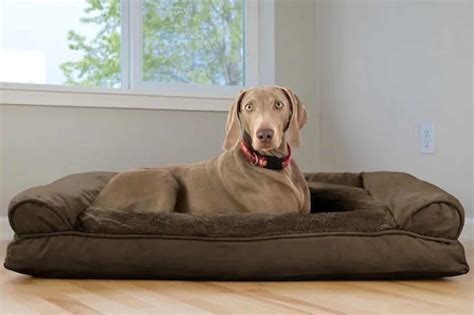Section 1: Understanding Your Large Dog’s Needs
Large breeds, weighing over 50 pounds, have unique sleeping requirements that must be met for optimal comfort and support. Their massive frames and heavy bones demand beds that offer ample space, sturdy construction, and tailored support to prevent joint pain, hip dysplasia, and other musculoskeletal issues.

Section 2: Types of Dog Beds for Large Breeds
Orthopedic Beds: Designed with memory foam or egg crate foam to conform to a dog’s body, providing pressure relief and optimal support for joints and muscles.
Elevated Beds: Raise dogs off the floor, promoting airflow and reducing heat buildup, making them ideal for warm climates and dogs prone to overheating.
Bolster Beds: Feature raised sides that provide a sense of security and support, allowing dogs to rest their heads or snuggle into the bolsters.
Cooling Beds: Made with breathable materials or cooling gels to dissipate heat, keeping dogs comfortable in warm weather or when active.
Crate Beds: Designed specifically to fit inside a dog’s crate, providing a comfortable and secure sleeping space within a confined area.
Section 3: Choosing the Right Size and Support
Size: Measure your dog’s length from nose to tail and add 12-18 inches to determine the ideal bed size. Ensure the bed provides enough space for stretching, rolling, and comfortable sleeping positions.
Support: Orthopedic and elevated beds offer superior support for large dogs’ joints and muscles. Consider your dog’s age, weight, and health conditions when selecting a bed.
Section 4: Materials and Durability
Materials: Choose beds made with durable materials such as canvas, nylon, or microsuede that can withstand wear and tear from large dogs. Look for waterproof materials for easy cleaning and odor control.
Durability: Consider the dog’s chewing habits and activity level. Beds with reinforced seams, Chew-proof materials, and heavy-duty construction will last longer.
Section 5: Comfort and Features
Comfort: Plush materials, soft cushioning, and ergonomic designs enhance comfort and promote restful sleep. Consider beds with removable covers for easy washing and a fresh scent.
Features: Look for beds with additional features such as built-in blankets, adjustable sides, or non-slip bottoms to enhance comfort and convenience.
Section 6: Common Mistakes to Avoid
Choosing a Bed That’s Too Small: A cramped bed can restrict movement, causing discomfort and potential health issues.
Not Considering Support: Lack of support can aggravate joint pain and lead to musculoskeletal problems.
Ignoring Durability: Cheap or poorly made beds may not withstand the weight and activity of a large dog, resulting in premature replacement costs.
Neglecting Hygiene: Unclean beds can harbor bacteria, mites, and unpleasant odors. Regular cleaning and maintenance are essential for a healthy sleeping environment.
Section 7: Frequently Asked Questions (FAQs)
1. How often should I wash my dog’s bed?
A: Every 1-2 weeks, depending on the dog’s activity level and cleanliness.
2. What is the best material for a dog bed?
A: Durable and chew-proof materials like canvas, nylon, or microsuede.
3. Should I get an orthopedic bed for my large dog?
A: Yes, if your dog is older, overweight, or has joint issues.
4. What is the difference between an elevated bed and a bolster bed?
A: Elevated beds promote airflow and cooling, while bolster beds provide a sense of security and support.
5. How long should a large dog bed last?
A: With proper care and maintenance, a high-quality dog bed should last for 2-5 years.
6. What is the average cost of a dog bed for large breeds?
A: The cost varies depending on size, materials, and features, but typically ranges from $50-$200.
Section 8: Future Trends and Innovations
Smart Beds: Beds that monitor dog’s sleep patterns, temperature, and activity levels, providing insights into their health and well-being.
Self-Cleaning Beds: Beds equipped with built-in odor control systems or UV light to eliminate bacteria and keep the bed fresh.
Interactive Beds: Beds with built-in toys, treats, or puzzles to engage and stimulate dogs while they sleep.
Section 9: Conclusion
Choosing the best dog bed for large breeds is essential for their comfort, support, and overall health. By following the guidelines outlined in this guide, you can select a bed that meets your dog’s unique needs and promotes a restful and rejuvenating sleep. Remember to consider size, support, materials, comfort, and features, and avoid common mistakes to ensure a comfortable and supportive sleeping space for your furry companion.





















